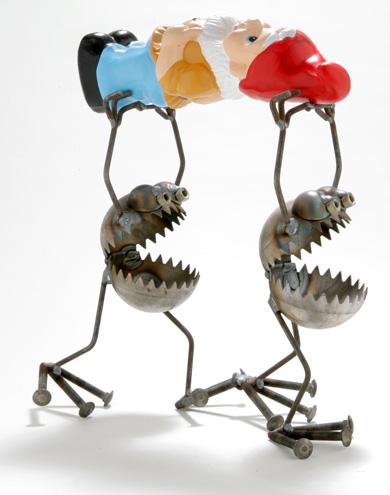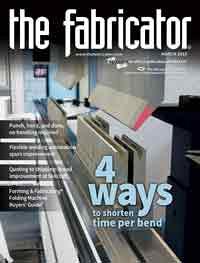- FMA
- The Fabricator
- FABTECH
- Canadian Metalworking
Categories
- Additive Manufacturing
- Aluminum Welding
- Arc Welding
- Assembly and Joining
- Automation and Robotics
- Bending and Forming
- Consumables
- Cutting and Weld Prep
- Electric Vehicles
- En Español
- Finishing
- Hydroforming
- Laser Cutting
- Laser Welding
- Machining
- Manufacturing Software
- Materials Handling
- Metals/Materials
- Oxyfuel Cutting
- Plasma Cutting
- Power Tools
- Punching and Other Holemaking
- Roll Forming
- Safety
- Sawing
- Shearing
- Shop Management
- Testing and Measuring
- Tube and Pipe Fabrication
- Tube and Pipe Production
- Waterjet Cutting
Industry Directory
Webcasts
Podcasts
FAB 40
Advertise
Subscribe
Account Login
Search
Cliché lawn art, be gone
Salt Lake City metal artist displays humorous, serious sides
- By Amanda Carlson
- April 1, 2015
- Article
- Arc Welding

While small-scale commissioned pieces are great, Conlon most enjoys making art that resonates well with the public and is affordable to boot.
Do you or someone you love have an ugly lawn art problem? Not sure? Do you have at least one pink flamingo on display? Are there any goofy little garden gnomes (like in the Travelocity commercials) hiding in your flower bed or on your front stoop?
If you responded “yes” to any or all of these questions, Fred Conlon, the metal artist behind Sugar Post, thinks you may have an ugly lawn art problem. Not to worry. The first step to recovery is admitting you have a problem.
But before we get into the nitty-gritty of your addiction or, better yet, Conlon’s foolproof recovery methods, let’s back up.
Replacing Clay With Metal
Conlon initially aspired to be in the pottery business. After graduating from the University of Utah with a degree in communications, he opened a pottery business and used money gifted to him from his grandmother to purchase pottery wheels, glazing ingredients, clay, and materials to build a kiln. The last $500 was used to pay the first month’s rent for his studio space.
But achieving the finished product with clay is a long process—much longer than with metal, for example. Conlon had some experience welding, and even used the skill to build his kiln and display shelves for his studio. But it wasn’t until someone offered to buy a metal trinket he had made just for fun that he even considered working with the material full time.
“I made a little turtle out of an old army helmet and sat it on the front porch of the pottery studio. Someone came by asking how much it was and I said, ‘$20,’ and she said, ‘OK, I’ll buy it!’ That got the juices flowing.”
Seventeen years after abandoning pottery in favor of working with metal, Conlon’s Sugar Post venture has five full-time and two part-time employees. Located in Salt Lake City, the crew travels all across the country participating in art shows, gift shows, public art programs, and craft expos, as well as keeping up with small commissioned work and the demand generated through Sugar Post’s website.
In addition to the art, Sugar Post also has mobile welding capabilities for structural and ornamental steel.
“I didn’t know if the art thing was going to work out and I still wanted to work for myself, so I bought an old work truck and outfitted it with a generator and welder so if the art thing never took off, at least I could still weld.
“As the art has continued to grow and grow, the structural [welding] has become a secondary thing. It gives us flexibility.”

Conlon leaves nothing to the imagination with Gnome Bearers, one in his Gnomes Be Gone series. Poor little gnome.
About That Gnome Problem
So what’s with the garden gnome phobia? Conlon’s hatred for garden gnomes, pink flamingos, and other lawn art of questionable taste goes back to his childhood when he found himself cornered and surrounded by garden gnomes. Ever since he has concluded that such objects are foul and must be replaced by art that’s cool. The series of Gnome Be Gone sculptures are designed to be just that—a cool alternative to traditional lawn decor. The added benefit to these little guys is their ability to wean ugly lawn art junkies off their affinity for cliché outdoor decor and replace it with a unique bit of hip metal flare.
“I needed a transition piece that would help people to get the junky stuff out of their yards and bring the cool stuff in, so I came up with the Gnome Be Gones to help make it easier for people to make that transition.
“There are still quite a few people who don’t know they have a gnome problem even though they do. They’re just not aware of it.”
But, seriously, he hates garden gnomes.
“People put some pretty stupid things in their yards, and I want them to put some cool things in their yards instead.”
Though Conlon’s sense of humor is reflected in much of his work, from reptiles, insects, and functional items for the kitchen and office to commissioned pieces, it can take a serious tone as well. His army helmet turtles were born initially as a small tribute to his grandfather, a World War II veteran who earned the Purple Heart for his service during the attack on Pearl Harbor.
“He said to me once that war happens quickly. After he passed away I was out at the Army/Navy Surplus place and I saw this giant pile of army helmets. I was thinking about my grandpa—this was about the time the U.S. was renewing their trade relations with Vietnam—and I thought, ‘Boy, war does happen quickly but peace, it seems, moves slowly.’ Turtles move slowly, and all of these army helmets looked like turtle shells, so I thought why not make a turtle out of an army helmet to say ‘War happens quickly, but peace moves slowly.’
Whether humorous, lighthearted, or somewhat serious, Conlon’s work has resonated well with people, which allows him to making a living doing something he loves. He’s also proof of what steady exercise in creativity can do.
“I think creativity is like a muscle. The more you use it, the stronger it becomes. If you don’t use it, it tends to atrophy and go away.”
About the Author

Amanda Carlson
2135 Point Blvd
Elgin, IL 60123
815-227-8260
Amanda Carlson was named as the editor for The WELDER in January 2017. She is responsible for coordinating and writing or editing all of the magazine’s editorial content. Before joining The WELDER, Amanda was a news editor for two years, coordinating and editing all product and industry news items for several publications and thefabricator.com.
subscribe now

The Fabricator is North America's leading magazine for the metal forming and fabricating industry. The magazine delivers the news, technical articles, and case histories that enable fabricators to do their jobs more efficiently. The Fabricator has served the industry since 1970.
start your free subscription- Stay connected from anywhere

Easily access valuable industry resources now with full access to the digital edition of The Fabricator.

Easily access valuable industry resources now with full access to the digital edition of The Welder.

Easily access valuable industry resources now with full access to the digital edition of The Tube and Pipe Journal.
- Podcasting
- Podcast:
- The Fabricator Podcast
- Published:
- 04/16/2024
- Running Time:
- 63:29
In this episode of The Fabricator Podcast, Caleb Chamberlain, co-founder and CEO of OSH Cut, discusses his company’s...
- Industry Events
16th Annual Safety Conference
- April 30 - May 1, 2024
- Elgin,
Pipe and Tube Conference
- May 21 - 22, 2024
- Omaha, NE
World-Class Roll Forming Workshop
- June 5 - 6, 2024
- Louisville, KY
Advanced Laser Application Workshop
- June 25 - 27, 2024
- Novi, MI































